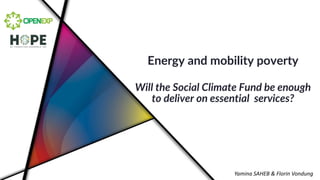
Energy and mobility poverty: Will the Social Climate Fund be enough to deliver on essential services?
- 1. Energy and mobility poverty Will the Social Climate Fund be enough to deliver on essential services? Yamina SAHEB & Florin Vondung
- 2. ‘Fit for 55’ suggests a potential emergence of the combined energy and mobility poverty while it is already a reality • The proposed Social Climate Fund does not aim at tackling the already existing energy and mobility poverty. Its objective is to tackle the expected impact of the extension of the EU ETS to building and road transport • European Pillar of Social Rights’ principle 20 states on the access to essential services states that “ Everyone has the right to access essential services of good quality, including water, sanitation, energy, transport, financial services and digital communications. Support for access to such services shall be available for those in need.” • Sustainable Development Goal 1 requires countries to end any type of poverty
- 3. While 6 EU binding instruments tackle energy poverty, none of the EU binding instruments tackles mobility poverty EU binding instruments tackling energy poverty EU binding instruments tackling mobility poverty 1-Directive on common rules for the internal market for electricity 2-Directive on common rules for the internal market in natural gas 3-Regulation on the Governance of the Energy Union and Climate Action 4-Directive on the Energy Performance of Buildings 5-Directive on Energy Efficiency 6-Directive on the promotion of the use of energy from renewable sources 🤔 None of the EU binding instruments aims at eradicating energy and mobility poverty
- 4. Market design of gas prices is an overlooked triggering factor of energy poverty Lowest income pay the highest price per unit of consumed gas
- 5. Market design of electricity prices is another overlooked triggering factor of energy poverty Lowest income pay the highest price per unit of consumed electricity
- 6. Market design of electricity prices is another overlooked triggering factor of energy poverty Lowest income pay the highest price per unit of consumed electricity
- 7. ‘Fit for 55’ makes an important but incomplete step towards defining energy poverty while it ignores mobility poverty Definition of energy poverty in the proposed revision of the EED By analogy, the following definition of mobility poverty is proposed ‘energy poverty’ means a household’s lack of access to essential energy services and lack of affordability of those services that underpin a decent standard of living and health, including adequate warmth, cooling, lighting, and energy to power appliances, in the relevant national context, existing social policy and other relevant policies. Energy poverty can be caused by one or the combination of the following factors: Low income, market design of gas and electricity prices leading to high energy expenditures for those consuming less and poor energy efficiency of homes. Mobility poverty means a household is unable to afford the necessary travels required to meet essential socio-economic needs in a given context and can be caused by one or the combination of the following factors, depending on national and local specificities: low income, high fuel expenditures and/or high costs of public transport, availability of other mobility alternatives and their accessibility and location, travelled distances, transport practices and the poor performance of vehicles. In red our suggestions to include in the ‘Fit for 55’ to ensure MSs will put in place measures to eradicate both energy and mobility poverty
- 8. EEPI and EMPI are composite indicators which combine existing indicators to assess energy and mobility poverty Best performing MSs in tackling energy poverty are not necessarily the best performing ones in tackling mobility poverty 2021 Ranking of MS using the European Energy Poverty Index (EEPI) for the 1st decile 2021 Ranking of MS using the European Mobility Poverty Index (EMPI) for the 1st decile
- 9. The European Well-Being Index (EWBI) ranks MSs by assessing the combined effect of energy and mobility poverty Addressing both energy and mobility poverty requires going beyond energy policies and considering land use, urban and housing policies 2021 Ranking of MS using the European Well-Being Index (EWBI) for the 1st decile
- 10. Moving forward • The combined energy and mobility poverty results from the urban sprawl triggered in the last three decades by land use, urban policies and housing policies • Leaving no one behind requires including requirements in EU binding instruments to eradicate both energy and mobility poverty as signed off by MSs in their SDGs • Ending energy poverty requires a fair market design and making existing buildings occupied by low-income zero energy buildings • An energy renovation agency is the ideal option to renovate dwellings occupied by low-income households • Limitations of the existing indicators to assess both energy and mobility poverty should be addressed urgently • Summer energy poverty should be included in the EC assessment of energy poverty • Mapping the combined energy and mobility poverty will accelerate eradicating both
- 11. Thank you for your attention More information on the combined energy and mobility poverty is available at European Well-Being Index Yamina SAHEB & Florin Vondung
